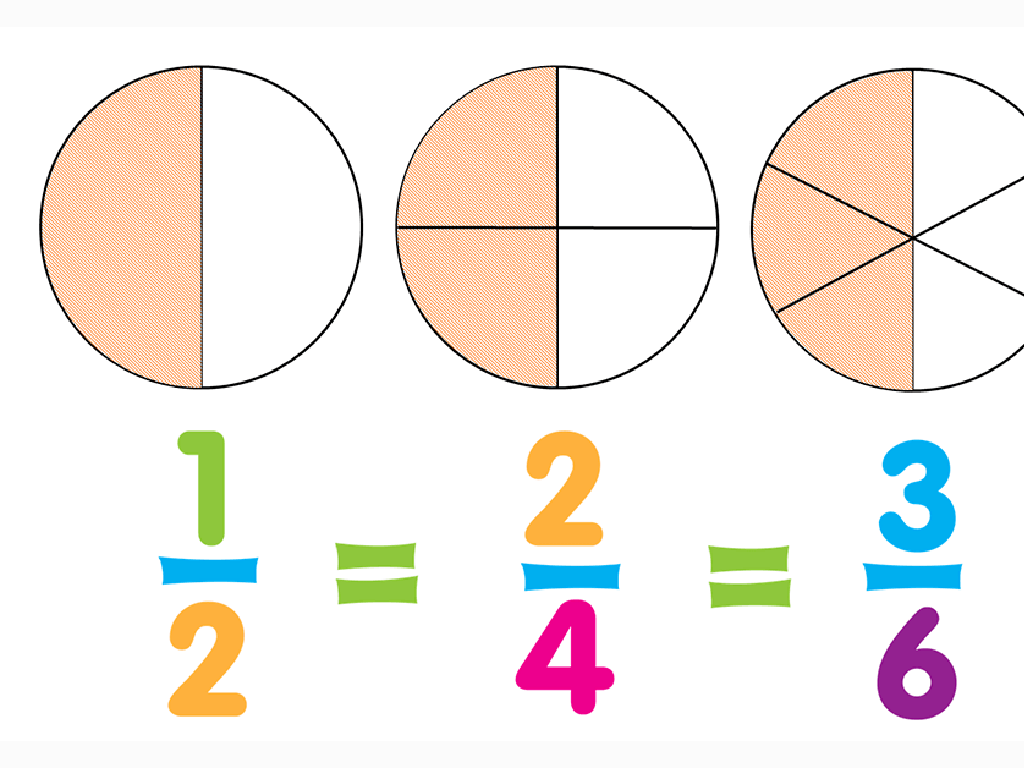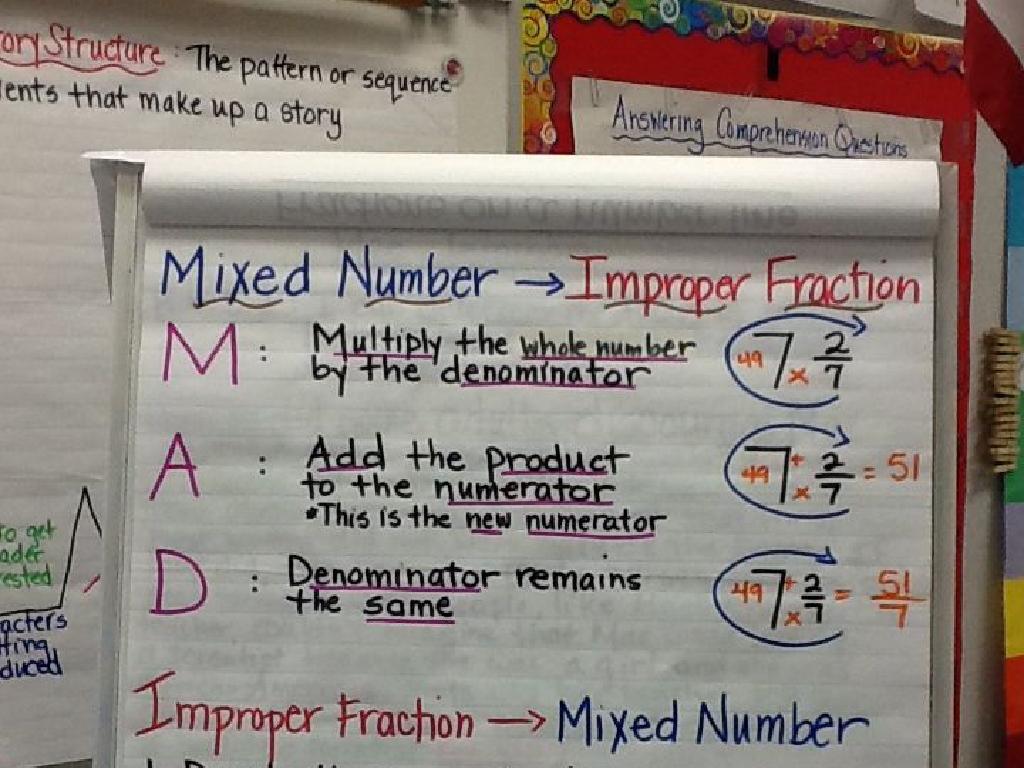Identify Equivalent Linear Expressions I
Subject: Math
Grade: Eighth grade
Topic: Equivalent Expressions
Please LOG IN to download the presentation. Access is available to registered users only.
View More Content
Welcome to Equivalent Expressions!
– Grasping equivalence concept
– Equivalence means two expressions have the same value.
– Defining Equivalent Expressions
– Expressions that simplify to the same value, e.g., 2(x + 3) and 2x + 6.
– Significance in algebra
– They allow us to solve equations and simplify expressions.
|
This slide introduces the foundational concept of equivalent expressions in algebra. Start by explaining that equivalence refers to different expressions that represent the same value, no matter what values their variables take. Then, define equivalent expressions as algebraic statements that, when simplified, result in the same value. Emphasize the importance of understanding equivalent expressions as they are crucial for solving algebraic equations and simplifying complex expressions. Provide examples to illustrate how different expressions can be equivalent, and encourage students to think of their own examples. This understanding is key to their success in algebra and future math courses.
What Makes Expressions Equivalent?
– Simplify to the same value
– e.g., 2(x + 3) and 2x + 6 both simplify to 12 when x=3
– Different forms, same meaning
– 3(x + 4) vs. 3x + 12: different look, identical results
– Examples of equivalent expressions
– 5(2y – 1) = 10y – 5 and (4y + 3) + (6y – 8) = 10y – 5
– Understanding equivalence
|
This slide introduces the concept of equivalent expressions in algebra. Equivalent expressions are different algebraic statements that simplify to the same value when the variables are replaced with the same numbers. Emphasize that while these expressions may appear different, they hold the same mathematical meaning. Provide clear examples to illustrate this point, such as showing how distributing or combining like terms can result in expressions that look different but are equivalent. Encourage students to practice with various expressions to gain a deeper understanding of equivalence in algebra.
Properties of Equality: Building Blocks
– Commutative Property of Addition
– Order doesn’t affect sum: e.g., 3 + 4 = 4 + 3
– Associative Property of Addition
– Grouping doesn’t affect sum: e.g., (2 + 3) + 4 = 2 + (3 + 4)
– Distributive Property
– Multiply through parentheses: e.g., 2(3 + 4) = 2*3 + 2*4
|
This slide introduces the foundational properties of equality that are essential for understanding equivalent linear expressions. The commutative property indicates that the order in which two numbers are added does not change the sum. The associative property shows that when adding three or more numbers, the way in which the numbers are grouped does not affect the sum. The distributive property allows us to multiply a single term by terms inside parentheses. Emphasize these properties with examples and encourage students to recognize these properties in practice to simplify expressions and identify equivalencies. This understanding is crucial for solving equations and understanding algebraic expressions in more complex math.
Identifying Equivalent Linear Expressions
– Linear expressions with one variable
– Expressions like 5x, x + 7, or 3x – 2
– Using properties to identify equivalence
– Commutative, associative properties
– Example: 3x + 2 and 2 + 3x
– Both simplify to the same expression
– Why are they equivalent?
– Commutative property of addition
|
This slide introduces students to the concept of equivalent linear expressions. Start by explaining linear expressions with one variable, emphasizing that they can take different forms but represent the same relationship. Discuss properties of equality and operations, such as the commutative and associative properties, which allow us to rearrange and group terms without changing the expression’s value. Use the example 3x + 2 and 2 + 3x to show these properties in action, demonstrating that despite the different order of terms, they simplify to the same expression. Encourage students to think about why these expressions are equivalent, guiding them to understand the underlying properties that justify their equivalence. This foundational understanding will be crucial for solving equations and simplifying expressions in future lessons.
Combining Like Terms
– Define like terms
– Terms with the same variable parts
– Steps to combine like terms
– Add coefficients of like terms
– Example: 2x + 3x
– Combine terms with ‘x’
– Simplified: 2x + 3x = 5x
– The sum of coefficients gives 5x
|
This slide introduces the concept of combining like terms as a fundamental skill in simplifying algebraic expressions. Like terms are terms that have the same variables raised to the same power. To combine them, simply add or subtract the coefficients (the numerical part of the terms) while keeping the variable part the same. For example, 2x and 3x are like terms because they both contain the variable ‘x’ to the first power. When we combine them, we add the coefficients (2 and 3) to get 5x. This process is crucial for solving equations and simplifying expressions. Encourage students to practice with additional examples and to check their understanding by identifying like terms in various expressions.
Simplifying Linear Expressions
– Steps to simplify expressions
– Practice: Simplify 4x + 3 + 2x
– Identify and group like terms: 4x and 2x
– Combine like terms
– Add the coefficients of like terms: 4 + 2
– Final simplified expression
– 6x + 3 is the simplified form
|
This slide introduces the concept of simplifying linear expressions by combining like terms. Start by explaining the steps to simplify an expression, which includes identifying like terms and combining them. Use the practice problem to demonstrate this process. Show that 4x and 2x are like terms because they both contain the variable x. Explain that you can add the coefficients of like terms together, which in this case is 4 + 2, resulting in 6x. Then, bring down any constants or other terms that are not like terms, which gives us the final simplified expression 6x + 3. Encourage students to practice with additional problems to reinforce the concept.
Class Activity: Finding Equivalent Expression Pairs
– Pair up with a classmate
– Find and write equivalent expressions
– For example, 3(x + 4) and 3x + 12 are equivalent
– Use properties to demonstrate equivalence
– Apply distributive, commutative, or associative properties
– Share your findings with the class
|
This activity is designed to encourage collaboration and application of mathematical properties to identify equivalent linear expressions. Students should work in pairs to foster teamwork and peer learning. They will use their understanding of properties such as distributive, commutative, and associative to find and verify the equivalence of different expressions. After completing the task, each pair will present their equivalent expressions to the class, explaining the reasoning behind their equivalence. This will help reinforce their understanding and allow for class discussion on the various methods used. Possible variations of the activity could include using algebra tiles, creating a gallery walk with different expressions around the room, or having a competition to see which pair can find the most equivalents.
Homework: Mastering Equivalent Expressions
– Practice with expression pairs
– Worksheet on simplifying
– Focus on combining like terms and using distributive property
– Study for the upcoming quiz
– Quiz will cover all topics discussed in class
– Review class notes and examples
– Revisit today’s examples and try additional problems
|
For homework, students should practice identifying pairs of equivalent linear expressions to reinforce their understanding. They must complete the provided worksheet, which focuses on simplifying expressions by combining like terms and applying the distributive property. This will prepare them for the quiz in the next class, which will encompass all aspects of equivalent expressions covered so far. Encourage students to review their class notes and rework examples given during lessons. Provide additional practice problems if possible to ensure they have ample opportunity to master the concepts.






